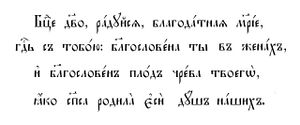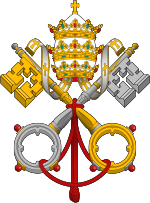Hail Mary
- For other uses, see Hail Mary (disambiguation) and Ave Maria (disambiguation).

The Angelic Salutation, Hail Mary, or Ave Maria (Latin) is a traditional Christian prayer asking for the intercession of the Virgin Mary, the mother of Jesus. The Hail Mary is used within Roman Catholicism, and it forms the basis of the Rosary. The prayer is also used by the Eastern Orthodox and Oriental Orthodox as well as by many other groups within the Catholic tradition of Christianity including Anglicans, Independent Catholics, and Old Catholics. Some Protestant denominations, such as Lutherans, also make use of the prayer. Most of the text of the Hail Mary can be found within the Gospel of Luke.
Biblical source

The prayer incorporates two passages from Saint Luke's Gospel: "Hail, full of grace, the Lord is with thee" (Luke 1 28: Χαῖρε, κεχαριτωμένη, ὁ Κύριος μετὰ σοῦ / Chaire, kecharitōmenē, o Kyrios meta sou), and "Blessed art thou amongst women and blessed is the fruit of thy womb" (Luke 1:42: Εὐλογημένη σὺ ἐν γυναιξὶν καὶ εὐλογημένος ὁ καρπὸς τῆς κοιλίας σου / eulogēmenē su en gynaixin kai eulogēmenos o karpos tēs koilias sou). In mid-13th-century Western Europe the prayer consisted only of these words with the single addition of the name "Mary" after the word "Hail", as is evident from the commentary of Saint Thomas Aquinas on the prayer.[1]
The first of the two passages from Saint Luke's Gospel is the greeting of the Angel Gabriel to Mary, originally written in Koine Greek. The opening word of greeting, χαῖρε, chaíre, here translated "Hail", literally has the meaning "Rejoice", "Be glad". This was the normal greeting in the language in which Saint Luke's Gospel is written and continues to be used in the same sense in Modern Greek. Accordingly, both "Hail" and "Rejoice" are valid English translations of the word ("Hail" reflecting the Latin translation, and "Rejoice" reflecting the original Greek).
The word κεχαριτωμένη, (kecharitōménē), here translated as "full of grace", admits of various translations. Grammatically, the word is the feminine present perfect passive voice participle of the verb χαριτόω[2], charitóō, which means "to show, or bestow with, grace" and, in the passive voice, "to have grace shown, or bestowed upon, one". The form of the verb is intensive, hence the translations "full of grace".[3]
The text also appears in the account of the annunciation contained in the apocryphal Infancy Gospel of Matthew, in chapter 9.
The prayer in Greek tradition
The Hail Mary prayer of the Eastern Orthodox Church and Eastern Catholic Churches is in the form: :Θεοτόκε Παρθένε, χαῖρε, κεχαριτωμένη Μαρία, ὁ Κύριος μετὰ σοῦ. εὐλογημένη σὺ ἐν γυναιξί, καὶ εὐλογημένος ὁ καρπὸς τῆς κοιλίας σου, ὅτι Σωτήρα ἔτεκες τῶν ψυχῶν ἡμῶν.[4]
-
- Theotokos Virgin, rejoice, Mary full of grace, the Lord is with you. Blessed are you among women, and blessed is the fruit of your womb, for you have borne the Saviour of our souls.
Another English rendering of the same text reads:
-
- Mother of God[5] and Virgin, rejoice, Mary full of grace, the Lord is with thee. Blessed art thou amongst women, and blessed is the fruit of thy womb, for thou hast given birth to the Saviour of our souls.
To the Biblical texts this adds the opening invocation "Theotokos Virgin", the name "Mary" and the concluding "for you have borne the Saviour of our souls".
The prayer in Western (Latin) tradition
|
General articles |
|
Expressions of devotion |
|
Specific articles |
After considering the use of similar words in Syriac, Greek and Latin in the 6th century, the article on the Hail Mary[6] in the Catholic Encyclopedia concludes that "there is little or no trace of the Hail Mary as an accepted devotional formula before about 1050", though a later pious tale attributed to Ildephonsus of Toledo (fl. 7th century) the use of the first part, namely the angel's greeting Mary, without that of Elizabeth, as a prayer.
Saint Thomas Aquinas spoke of the name "Mary", which served to indicate who was the "full of grace" person mentioned, as the only word added at his time to the Biblical text. But at about the same time the name "Jesus" was also added, to specify who was meant by the phrase "the fruit of thy womb".
The Western version of the prayer is thus not derived from the Greek version: even the earliest Western forms have no trace of the Greek version's phrases: "Mother of God and Virgin" and "for thou hast given birth to the Saviour of our souls".
To the greeting and praise of Mary of which the prayer thus consisted, a petition "Holy Mary, Mother of God, pray for us sinners now and at the hour of our death. Amen", was added later. The petition first appeared in print in 1495 in Girolamo Savonarola's "Esposizione sopra l’Ave Maria"[7]. The "Hail Mary" prayer in Savonarola's exposition reads:
- Hail Mary, full of grace, the Lord is with thee; blessed art thou among women, and blessed is the fruit of thy womb, Jesus. Holy Mary, Mother of God, pray for us sinners, now and at the hour of our death. Amen[8]
The petition was commonly added around the time of the Council of Trent. The Dutch Jesuit Petrus Canisius is credited with adding in 1555 in his Catechism the sentence:
- Holy Mary, Mother of God, pray for us sinners. [9]
Eleven years later, the sentence was included in the Catechism of the Council of Trent of 1566. The "Catechism of the Council of Trent" says that to the first part of the Hail Mary, by which "we render to God the highest praise and return Him most gracious thanks, because He has bestowed all His heavenly gifts on the most holy Virgin ... the Church of God has wisely added prayers and an invocation addressed to the most holy Mother of God ... we should earnestly implore her help and assistance; for that she possesses exalted merits with God, and that she is most desirous to assist us by her prayers, no one can doubt without impiety and wickedness."[10]
The current Latin version is thus as follows, with accents added to indicate how the prayer is said in the current ecclesiastical pronunciation of Latin:
- Áve María, grátia pléna, Dóminus técum. Benedícta tu in muliéribus, et benedíctus frúctus véntris túi, Iésus.[11]
- Sáncta María, Máter Déi, óra pro nóbis peccatóribus, nunc et in hóra mórtis nóstrae. Ámen.
A version with macrons follows for any who wish to recite the prayer with the restored classical pronunciation of Latin (note however that since the accents of the previous version refer to stress accent, and the macrons to vowel length, there is no incompatibility between the two notations).
- Avē Marīa, grātiā plēna, Dominus tēcum. Benedicta tū in mulieribus, et benedictus frūctus ventris tuī, Iēsus.
- Sāncta Marīa, Māter Deī, ōrā prō nōbīs peccātōribus, nunc et in hōrā mortis nostrae. Āmēn.
In English:
- Hail Mary, full of grace, the Lord is with thee; blessed art thou amongst women, and blessed is the fruit of thy womb, Jesus.
- Holy Mary, Mother of God, pray for us sinners, now and at the hour of our death. Amen.
For translations from the Latin into various languages, see Wikisource.
Usage in the Eastern Orthodox and Eastern Catholic Churches

In the Eastern Orthodox and Byzantine Rite Eastern Catholic Churches, the prayer is very common in the Greek form indicated above, or in translations from it. Although it is not said quite as often as in the West, it is well known, oft-used, and appears in several canons of prayer. It is typically sung thrice at the end of Vespers during an All-Night Vigil, as well as occurring many times in the course of daily prayer.
Slavonic versions of the Greek prayer
There exist two variant versions in Church Slavonic:
|
Богородице дѣво радѹйсѧ |
Theotokos Virgin, rejoice, (or: Rejoice, O Virgin Theotokos) |
|
Богородице дѣво, радѹйсѧ, |
Theotokos Virgin, rejoice, (or: Rejoice, O Virgin Theotokos) |

The first is the older, and remains in use by the Old Believers as well as those who follow the Ruthenian recension (among them the Ukrainian Greek-Catholic Church and the Ruthenian Catholic Church). The second appeared in 1656 under the liturgical reforms of Patriarch Nikon of Moscow, and is in use by the Russian Orthodox Church, the Serbian Orthodox Church, the Bulgarian Orthodox Church and the Ukrainian Orthodox Church).
Usage in the Roman Catholic Church
| Roman Catholic Mariology A series of articles on |
|
 |
|
|
Alma Redemptoris Mater |
|
The Hail Mary is the essential element of the Rosary, a prayer method in use especially among Latin Rite (Western) Catholics, and that appears in the East only among Latinised Ukrainian and Maronite Catholics. The Rosary consists traditionally of three sets of five Mysteries, each mystery consisting of one "decade" or ten Ave Marias. The 150 Ave Marias of the Rosary thus echo the 150 psalms. These meditate upon events of Jesus' life during his childhood (Joyful Mysteries), Passion (Sorrowful Mysteries), and from his Resurrection onwards (Glorious Mysteries). Another cycle of mysteries, called the Luminous Mysteries, is of comparatively recent origin, having been proposed by Pope John Paul II in 2002. Each of these Mysteries is prayed as a decade (a unit of ten), consisting of one Our Father (Pater Noster or The Lord's Prayer), ten Hail Marys, and one 'Glory Be' (Gloria Patri) (Doxology).
The Hail Mary is also the central part of the Angelus, a devotion generally recited thrice daily by many Catholics, as well as some Anglicans and Lutherans.
Anglican use of the Hail Mary
Anglo-Catholics also employ the Hail Mary in devotional practice. Traditional Anglo-Catholics use the prayer in much the same way as the Roman Catholics, including use of the Rosary and the recitation of the Angelus. Many Anglican churches contain statues of the Virgin Mary, and the faithful use devotional prayers including the Hail Mary.
Lutheran usage
Martin Luther, the founder of Lutheranism, believed that Mary should be held in highest reverence. Although he did not agree in Mary's veneration[12], he did advocate the use of the first half of the Hail Mary (that is, "Hail Mary, full of grace, the Lord is with thee. Blessed art thou among women and blessed is the fruit of thy womb, Jesus.") as a sign of reverence for and devotion to the Virgin.[13]
Musical settings
The Hail Mary or Ave Maria in Latin has been set to music numerous times. Among the most famous settings is the version by Charles Gounod (1859), adding melody and words to Johann Sebastian Bach's first prelude from the Well-Tempered Clavier. Antonín Dvořák's version was composed in 1877. Another setting of Ave Maria was written by Giuseppe Verdi for his 1887 opera Otello. Russian composer César Cui, who was raised Roman Catholic, set the text at least three times: as the "Ave Maria", op. 34, for 1 or 2 women's voices with piano or harmonium (1886), and as part of two of his operas: Le Flibustier (premiered 1894) and Mateo Falcone (1907). Settings also exist by Mozart, Byrd, Elgar, Verdi, Saint-Saëns, Rossini, Brahms, Stravinsky, Schubert, and Perosi as well as numerous versions by less well-known composers, such as J.B. Tresch. Anton Bruckner wrote three different settings.
In Slavonic, the text was also a popular subject for setting to music by Eastern European composers. These include Rachmaninov, Stravinsky, Bortniansky and several others.
This text was also very often set by composers in the Renaissance, including Josquin des Prez, Orlando di Lasso, and Giovanni Pierluigi da Palestrina. Before the Council of Trent there were actually different versions of the text, so the earlier composers in the period sometimes set versions of the text different from the ones shown above. Josquin Desprez, for example, himself set more than one version of the Ave Maria. Here is an example of a text set by Josquin which begins with the first six words above, but continues with a poem in rhymed couplets:
Ave Maria, gratia plena, Dominus tecum, Virgo serena.
Ave cuius conceptio,
solemni plena gaudio,
celestia, terrestria,
nova replet letitia.
Ave cuius nativitas,
nostra fuit solemnitas,
ut lucifer lux oriens
verum solem preveniens.
Ave pia humilitas,
sine viro fecunditas,
cuius annunciatio
nostra fuit salvatio.
Ave vera virginitas,
immaculata castitas,
cuius purificatio
nostra fuit purgatio.
Ave preclara omnibus
angelicis virtutibus,
cuius fuit assumptio
nostra glorificatio.
O Mater Dei, memento mei. Amen.
The much anthologized Ave Maria 'by' Jacques Arcadelt is actually a 19th century arrangement by Pierre-Louis Dietsch, loosely based on Arcadelt's three part madrigal Nous voyons que les hommes.
Franz Schubert's Ellens dritter Gesang (D839, Op 52 no 6, 1825) [14] is often performed with the Ave Maria prayer sung in place of the original text; this is misidentified as "Schubert's Ave Maria". The original text of Schubert's song is from Sir Walter Scott's The Lady of the Lake and was translated into German by Adam Storck; it opens with the greeting "Ave Maria" ("Hail Mary"), but is not a setting of the traditional Ave Maria prayer. In Walt Disney's Fantasia, the tune is used with yet another text beginning with the phrase.
Even though Protestant Christianity generally avoids any special veneration of Mary, access to the beautiful and culturally significant tradition of Marian music is facilitated by substitution texts. These texts are intended to replace the words of the standard "Ave Maria", preserving word boundaries and syllable stresses, so that music written for the former text can be sung with the latter. An example is the Christ-centric Ave Redemptor:
| English translation | |
|---|---|
|
Ave redemptor, Domine Jesus: |
Hail the Redeemer, Lord Jesus, |
A famous setting for the Orthodox version of the prayer in Church Slavonic was composed by Sergei Rachmaninoff in his All-Night Vigil.
See also
- Theotokos
- Marian devotions
- Mary, the mother of Jesus
- Catholic beliefs on the power of prayer
- Mariology, the theological study of Mary
- The Glories of Mary
- Prayer beads and prayer rope
- Marian apparitions
- Marian shrine
- Rosary
- Hail Mary pass
References

- ↑ Saint Thomas Aquinas on the Hail Mary
- ↑ http://www.perseus.tufts.edu/cgi-bin/ptext?doc=Perseus%3Atext%3A1999.04.0057%3Aentry%3D%23113414
- ↑ To render the meaning of the Greek intensive verb, the early Latin translators of the New Testament, who had no corresponding verb in their language, felt the need to use the phrase "gratia plena" (full of grace).
- ↑ text, with chanting
- ↑ It should be noted that "Mother of God" is not an accurate translation for the Greek word Theotokos, which has very specific theological implications. "Mother of God" is the literal translation of a different Greek term, Μήτηρ Θεού, (Mitir Theou).
- ↑ Thurston, Herbert (1910), "Hail Mary", The Catholic Encyclopedia, VII, New York: Robert Appleton Company, http://www.newadvent.org/cathen/07110b.htm, retrieved 2007-09-19
- ↑ British Library - Rare Books Department, shelfmark: IA 27542 ([1])
- ↑ The prayer is printed in latin on the first page of the exposition and reads: "Ave Maria gratia plena Dominus tecum Benedicta tu in mulieribus et benedictus Fructus uentris tui Iesus sancta Maria mater Dei ora pro nobis peccatoribus nunc et in hora mortis Amen"
- ↑ This sentence appeared for he first time in his catechism of 1555 : Petrus Canisius, CATECHISMI Latini et Germanici, I, ( ed Friedrich Streicher, S P C CATECHISMI Latini et Germanici, I, Roma, Munich, 1933, I, 12
- ↑ The Catechism of the Council of Trent, Part IV
- ↑ With Pope John XXIII's edition of the Roman Missal, the use of the letter J in printing Latin was dropped even in liturgical books, which had preserved that usage long after it ceased in the printing of ordinary Latin texts, including documents of the Holy See.
- ↑ Luther's views on Mary's veneration
- ↑ Luther's Works, 10 II, 407–409
- ↑ Ave Maria, D.839 (Schubert, Franz) music score in Public Domain Petrucci Music Library
External links
- Ave Maria on video/audio sung by Sharon Janis
- Catholic Encyclopedia 1910: Hail Mary
- Brief commentary on the Hail Mary from the Catechism of the Catholic Church
- Ave Maria article in Christian Cyclopedia
- Various Ave Maria hymn Ave Maria(MIDI by JE1EMU)
- Text of the Hail Mary in many foreign languages
- Rejoice, O Virgin, setting by Rachmaninoff (mp3)
|
|||||||||||||||||||||

